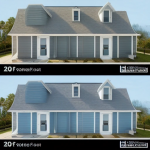How to Choose the Right Roofing Material for Durability and Aesthetics
Introduction: The Roof as a Cornerstone of Home Protection and Style
The roof over your head is far more than a mere covering; it’s a critical structural component and a significant aesthetic element that defines your home. As a substantial home improvement investment, selecting the right roofing material requires careful consideration of factors extending beyond simple cost. Durability, aesthetics, long-term performance, and even environmental impact play crucial roles in ensuring you choose a roof that not only protects your home from the elements but also enhances its curb appeal and overall value.
A poorly chosen roof can lead to premature failure, manifesting as leaks, structural damage, and costly repairs, ultimately diminishing your property’s value and aesthetic presence. Conversely, a well-selected roof, installed with precision and maintained diligently, can provide decades of reliable protection, significantly improve energy efficiency, and elevate your home’s exterior design. The selection of roofing materials directly impacts a home’s exterior design, influencing its architectural style and visual appeal. For example, asphalt shingles, the most common roofing material, offer a wide range of colors and textures, making them suitable for various architectural styles, from traditional to contemporary.
Metal roofing, with its sleek lines and modern aesthetic, complements contemporary and farmhouse-style homes while providing exceptional durability. Clay and concrete tiles evoke a sense of timeless elegance, perfectly suited for Mediterranean and Spanish Colonial designs. Beyond aesthetics, the material’s properties directly correlate with roof durability. Metal roofing, for example, boasts superior resistance to fire, wind, and impact, making it a robust choice for regions prone to extreme weather conditions. Understanding these material properties is fundamental to aligning your roofing choice with your home’s design and environmental context.
Furthermore, the cost of roofing extends beyond the initial price of the materials. Roof installation costs can vary significantly depending on the material chosen, the complexity of the roof design, and the labor involved. Asphalt shingles generally have lower installation costs compared to metal, clay, or concrete tiles, making them an attractive option for budget-conscious homeowners. However, it’s crucial to consider the long-term roof maintenance costs associated with each material. While asphalt shingles may have a lower upfront cost, they typically require more frequent repairs and replacements compared to more durable options like metal or tile roofing.
Therefore, a comprehensive cost analysis should factor in the lifespan of the material, potential repair needs, and the impact on your home’s energy efficiency. Investing in high-quality roofing materials can lead to significant long-term savings and enhance your home’s overall value. This comprehensive guide delves into the complex world of roofing materials, providing you with the knowledge and insights necessary to make an informed decision. We’ll explore the pros and cons of various options, from traditional asphalt shingles to durable metal roofing and elegant clay tiles, examining their material science underpinnings, installation requirements, and long-term performance characteristics. By carefully considering factors such as climate, budget, architectural style, and long-term maintenance costs, you can choose a roofing material that not only safeguards your investment but also elevates your home’s overall appeal, creating a lasting legacy of protection and beauty.
Asphalt Shingles: The Affordable and Versatile Standard
Asphalt shingles remain the dominant roofing material across North America, a testament to their attractive blend of affordability and straightforward installation. Their widespread appeal also stems from the sheer variety of colors and styles available, enabling homeowners to seamlessly integrate them with diverse architectural designs, from traditional to contemporary. While asphalt shingles offer an accessible entry point for many homeowners, it’s crucial to acknowledge that their lifespan is comparatively shorter than other roofing materials, typically spanning 15 to 30 years depending on the climate and quality of the shingle.
This makes understanding the nuances of asphalt shingle composition and performance essential for informed decision-making in home improvement projects. Within the realm of asphalt shingles, two primary types exist: organic and fiberglass. Organic shingles, crafted from a recycled paper mat saturated with asphalt, present a heavier, more environmentally conscious option. However, they exhibit a lower fire resistance compared to their fiberglass counterparts. Fiberglass shingles, constructed from a woven fiberglass mat coated with asphalt and embedded with mineral granules, offer enhanced fire resistance, lighter weight, and generally improved durability.
The mineral granules not only provide color and aesthetic appeal but also play a critical role in protecting the asphalt layer from UV degradation, a key factor influencing the long-term performance of the roof. Understanding these material science distinctions is crucial for selecting the appropriate shingle type based on regional climate and building codes. When considering asphalt shingles, a thorough evaluation of their cost-effectiveness in relation to their lifespan and resilience to local weather conditions is paramount.
While their initial cost is lower, the potential for more frequent replacements compared to materials like metal roofing or clay tiles must be factored into the long-term cost analysis. In regions prone to severe weather events, such as hailstorms or high winds, investing in thicker, impact-resistant asphalt shingles is a prudent strategy. These specialized shingles, often engineered with modified asphalt formulations and reinforced cores, can significantly extend the roof’s lifespan and minimize the risk of costly repairs. Furthermore, proper roof installation and regular maintenance, including cleaning and addressing minor repairs promptly, are essential for maximizing the lifespan and performance of asphalt shingle roofs. The choice of underlayment and proper ventilation also play crucial roles in preventing moisture damage and ensuring the longevity of the roofing system.
Metal Roofing: Durability and Energy Efficiency for the Long Haul
Metal roofing, encompassing materials like steel, aluminum, copper, and zinc, offers exceptional durability and longevity, often lasting 50 years or more. While the initial cost is higher than asphalt shingles, metal roofs provide superior resistance to fire, wind, and impact, making them a sound investment for homeowners in regions prone to extreme weather. Their reflective properties can also significantly reduce energy consumption in warmer climates, lowering cooling costs and contributing to a more sustainable home.
From a materials science perspective, the inherent properties of these metals—such as steel’s tensile strength and aluminum’s corrosion resistance—directly translate to enhanced roof durability and reduced long-term maintenance needs. This makes metal roofing a compelling option when considering lifecycle costs. Standing seam metal roofs, characterized by their interlocking panels, are particularly popular for their sleek, modern aesthetic and watertight performance. The concealed fastener system not only contributes to a cleaner look, enhancing exterior design, but also minimizes potential leak points, further extending the roof’s lifespan.
Metal roofs are available in a wide array of colors and finishes, including those that mimic the appearance of traditional roofing materials like slate or wood shakes, allowing for customization to suit various architectural styles. For home improvement projects focused on increasing property value, metal roofing offers a significant return on investment due to its longevity and curb appeal. Considerations: Metal roofs can be noisy during heavy rain or hail, although this can be mitigated with proper insulation, sound-deadening underlayments, or even textured metal finishes that help to diffuse the impact of raindrops.
The initial investment is substantial, but the long lifespan and energy savings can offset the higher cost over time, making it a financially sound choice for many homeowners. In coastal areas, aluminum roofing is preferred due to its superior corrosion resistance compared to steel, especially when exposed to saltwater. Furthermore, the recyclability of metal roofing materials aligns with environmentally conscious home improvement practices, reducing the environmental footprint compared to asphalt shingles that often end up in landfills.
From an engineering standpoint, the installation of metal roofing requires specialized skills to ensure proper fastening and sealing, which are crucial for preventing leaks and maximizing wind resistance. Factors such as roof pitch, panel orientation, and the type of underlayment used all play a critical role in the overall performance of a metal roofing system. Selecting a qualified roofing contractor with experience in metal roof installation is essential to guarantee a durable and weathertight roof. Additionally, homeowners should consider the thermal expansion and contraction properties of different metal roofing materials, as this can affect the design and installation process, particularly in regions with significant temperature fluctuations. Understanding these material science aspects is key to ensuring long-term roof durability and performance.
Clay and Concrete Tiles: Timeless Elegance and Enduring Performance
Clay and concrete tiles present a roofing option steeped in history and architectural significance, instantly evoking the sun-drenched landscapes of the Mediterranean and the stately elegance of Spanish Colonial designs. These materials distinguish themselves through exceptional durability, often exceeding a lifespan of 50 years, and inherent fire resistance, providing a robust shield against external threats. Clay tiles, crafted from natural clay and hardened through intense firing, offer a classic, earthy aesthetic. Concrete tiles, a blend of cement, sand, and water, provide a more versatile canvas, capable of mimicking the appearance of slate, wood shake, or traditional clay, expanding their applicability across diverse architectural styles.
Both materials represent a long-term investment in both roof durability and roof aesthetics. The appeal of clay and concrete tiles extends beyond their longevity; they offer a remarkable degree of customization to enhance exterior design. Available in a diverse palette of shapes, colors, and textures, these roofing materials allow homeowners to tailor their roofs to complement their unique architectural vision. From the rustic charm of barrel tiles to the sleek lines of flat concrete tiles, the options are plentiful.
Furthermore, their considerable thermal mass contributes to energy efficiency. By absorbing and slowly releasing heat, these tiles help regulate indoor temperatures, reducing the reliance on air conditioning in hot climates and minimizing heat loss during colder months, leading to tangible savings on energy bills and improved home improvement. However, the selection of clay or concrete tiles necessitates careful consideration of structural requirements and roofing cost. Their substantial weight demands a robust roof structure, potentially requiring reinforcement, especially in older homes.
This added structural work, combined with the specialized skills required for roof installation, translates to higher upfront costs compared to lighter roofing materials like asphalt shingles. Moreover, regions prone to seismic activity require specialized installation techniques, such as interlocking systems and seismic clips, to ensure the tiles remain securely fastened during an earthquake. Regular roof maintenance, including inspections and occasional repairs, is crucial to preserving the integrity and appearance of tile roofs, particularly in areas with harsh weather conditions.
Despite these considerations, the enduring performance and timeless beauty of clay and concrete tiles often outweigh the initial investment for homeowners seeking a distinctive and long-lasting roofing solution. From a materials science perspective, the composition of clay and concrete tiles directly contributes to their performance characteristics. The high firing temperatures used in manufacturing clay tiles result in a product that is incredibly resistant to weathering, UV degradation, and insect damage. Concrete tiles, while not fired, gain strength and durability through the hydration process of cement, resulting in a dense and resilient material. The permeability of both materials can be controlled through surface treatments and coatings, enhancing their resistance to water absorption and freeze-thaw cycles. This careful control over material properties ensures that clay and concrete tiles can withstand a wide range of environmental conditions, making them a reliable choice for homeowners prioritizing long-term roof durability.
Conclusion: Investing in a Roof That Protects and Enhances Your Home
Selecting the right roofing material is a significant decision that impacts your home’s value, protection, and aesthetic appeal. By carefully considering factors such as climate, budget, architectural style, and long-term maintenance costs, you can choose a roofing material that provides decades of reliable performance and enhances your home’s beauty. Whether you opt for the affordability of asphalt shingles, the durability of metal roofing, or the timeless elegance of clay tiles, a well-chosen roof is an investment that protects your home and provides peace of mind for years to come.
Consulting with a qualified roofing contractor is essential to ensure proper roof installation and maximize the lifespan of your chosen material. The interplay between material science and exterior design is particularly evident in roofing choices. For instance, advancements in asphalt shingles now offer enhanced UV resistance and algae-fighting properties, increasing roof durability and maintaining aesthetic appeal in humid climates. Metal roofing, particularly options like coated steel and aluminum, benefits from sophisticated alloys and paint systems that prevent corrosion and fading, ensuring long-term performance and visual appeal.
Even concrete tiles are engineered with specific pigments and surface treatments to resist weathering and maintain their color integrity, showcasing how materials science contributes directly to the longevity and beauty of roofing materials. Furthermore, the long-term roofing cost extends beyond the initial purchase price. While asphalt shingles may have a lower upfront cost, their shorter lifespan and higher maintenance requirements can lead to greater expenses over time. Metal roofing and clay tiles, despite their higher initial investment, often prove more cost-effective due to their superior roof durability and minimal maintenance needs.
Consider also the impact on home improvement projects; a durable and aesthetically pleasing roof can significantly increase your home’s resale value, making it a worthwhile investment. Evaluating these factors through a life-cycle cost analysis is crucial for making an informed decision that aligns with your budget and long-term homeownership goals. Ultimately, the selection of roofing materials should be a holistic decision, integrating considerations from roofing, home improvement, exterior design, and materials science perspectives. Factors such as local building codes, energy efficiency requirements, and environmental impact should also be weighed. For example, cool roofing options, like light-colored metal roofing or specially coated asphalt shingles, can reduce energy consumption by reflecting sunlight and lowering roof temperatures. By carefully evaluating all these aspects and working with experienced professionals, you can ensure that your new roof not only protects your home but also enhances its value and curb appeal for years to come.


